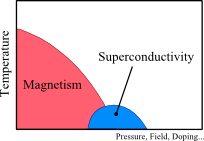Researches
Superconductivity in strongly correlated electrons system
 Since the discovery of superconductivity a century ago,
magnetism was believed, until recently, to be incompatible with superconductivity.
This common understanding was collapsed in 80s by the
discovery of superconductivity in the vicinity of magnetic instability.
Cupper oxide high transition temperature superconductor is one of the most famous example.
Since the discovery of superconductivity a century ago,
magnetism was believed, until recently, to be incompatible with superconductivity.
This common understanding was collapsed in 80s by the
discovery of superconductivity in the vicinity of magnetic instability.
Cupper oxide high transition temperature superconductor is one of the most famous example.
For this class of superconductivity, many researchers now believe that two electrons can form superconducting pair through the electron-electron correlations. This scenario sounds strange, if one reminds that the Coulomb interaction between negative charges is "repulsive".
In a condensed matter, however, the Coulomb repulsion can induce "attractive" interaction because of the many body effects. This paradox is clearly described in the famous sentence "More is different" by P. W. Anderson.
We are interested in the properites of unconventional superconductivity found nearby a magnetic phase. The unconventional superconductors have several features distinct from conventional one, which is understood in the BCS framework. Superconducting order parameter, for instance, is angle dependent in the unconventional superconductor, as a result of strange pairing ineraction.
Superconductivity in organic conductors is one of our main topic, and is explained in physics in organic conductors.